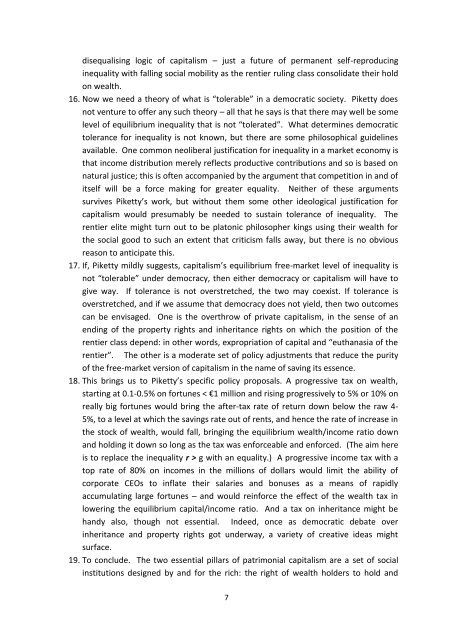Piketty for dummies
Piketty for dummies
Piketty for dummies
- No tags were found...
Create successful ePaper yourself
Turn your PDF publications into a flip-book with our unique Google optimized e-Paper software.
disequalising logic of capitalism – just a future of permanent self-reproducinginequality with falling social mobility as the rentier ruling class consolidate their holdon wealth.16. Now we need a theory of what is “tolerable” in a democratic society. <strong>Piketty</strong> doesnot venture to offer any such theory – all that he says is that there may well be somelevel of equilibrium inequality that is not “tolerated”. What determines democratictolerance <strong>for</strong> inequality is not known, but there are some philosophical guidelinesavailable. One common neoliberal justification <strong>for</strong> inequality in a market economy isthat income distribution merely reflects productive contributions and so is based onnatural justice; this is often accompanied by the argument that competition in and ofitself will be a <strong>for</strong>ce making <strong>for</strong> greater equality. Neither of these argumentssurvives <strong>Piketty</strong>’s work, but without them some other ideological justification <strong>for</strong>capitalism would presumably be needed to sustain tolerance of inequality. Therentier elite might turn out to be platonic philosopher kings using their wealth <strong>for</strong>the social good to such an extent that criticism falls away, but there is no obviousreason to anticipate this.17. If, <strong>Piketty</strong> mildly suggests, capitalism’s equilibrium free-market level of inequality isnot “tolerable” under democracy, then either democracy or capitalism will have togive way. If tolerance is not overstretched, the two may coexist. If tolerance isoverstretched, and if we assume that democracy does not yield, then two outcomescan be envisaged. One is the overthrow of private capitalism, in the sense of anending of the property rights and inheritance rights on which the position of therentier class depend: in other words, expropriation of capital and “euthanasia of therentier”. The other is a moderate set of policy adjustments that reduce the purityof the free-market version of capitalism in the name of saving its essence.18. This brings us to <strong>Piketty</strong>’s specific policy proposals. A progressive tax on wealth,starting at 0.1-0.5% on <strong>for</strong>tunes < €1 million and rising progressively to 5% or 10% onreally big <strong>for</strong>tunes would bring the after-tax rate of return down below the raw 4-5%, to a level at which the savings rate out of rents, and hence the rate of increase inthe stock of wealth, would fall, bringing the equilibrium wealth/income ratio downand holding it down so long as the tax was en<strong>for</strong>ceable and en<strong>for</strong>ced. (The aim hereis to replace the inequality r > g with an equality.) A progressive income tax with atop rate of 80% on incomes in the millions of dollars would limit the ability ofcorporate CEOs to inflate their salaries and bonuses as a means of rapidlyaccumulating large <strong>for</strong>tunes – and would rein<strong>for</strong>ce the effect of the wealth tax inlowering the equilibrium capital/income ratio. And a tax on inheritance might behandy also, though not essential. Indeed, once as democratic debate overinheritance and property rights got underway, a variety of creative ideas mightsurface.19. To conclude. The two essential pillars of patrimonial capitalism are a set of socialinstitutions designed by and <strong>for</strong> the rich: the right of wealth holders to hold and7


